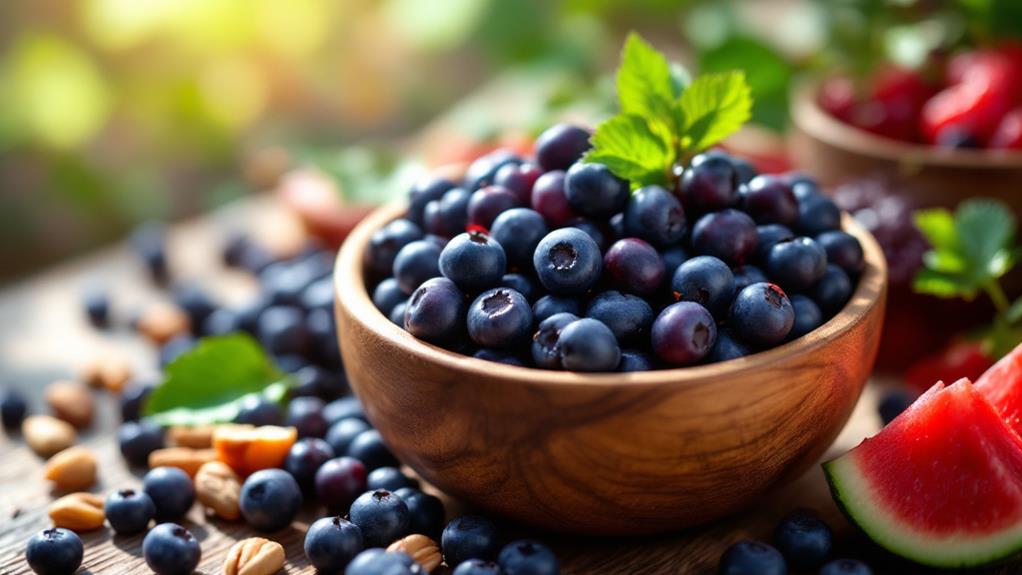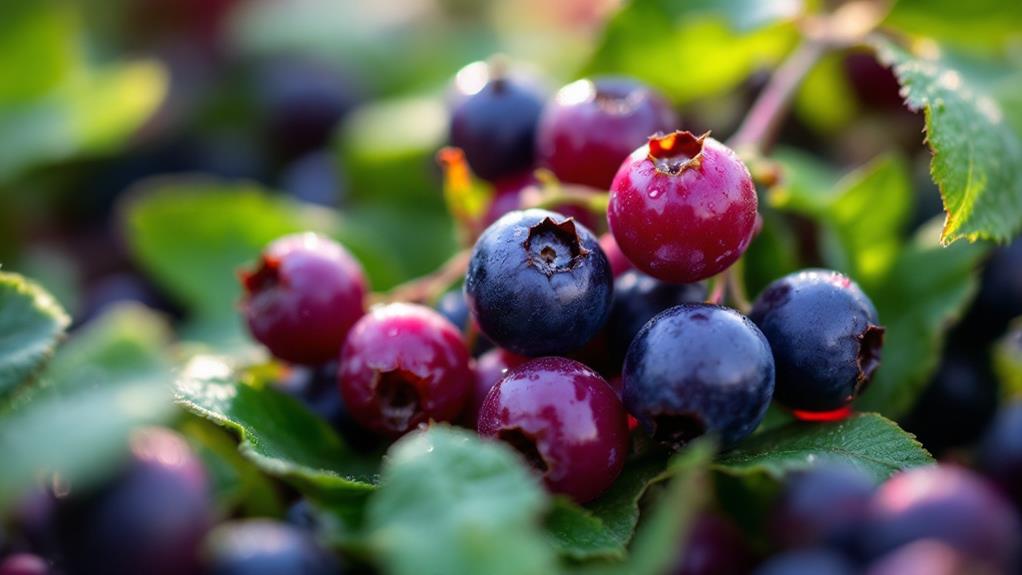The Ultimate Guide to Different Types of Grains and Their Health Benefits
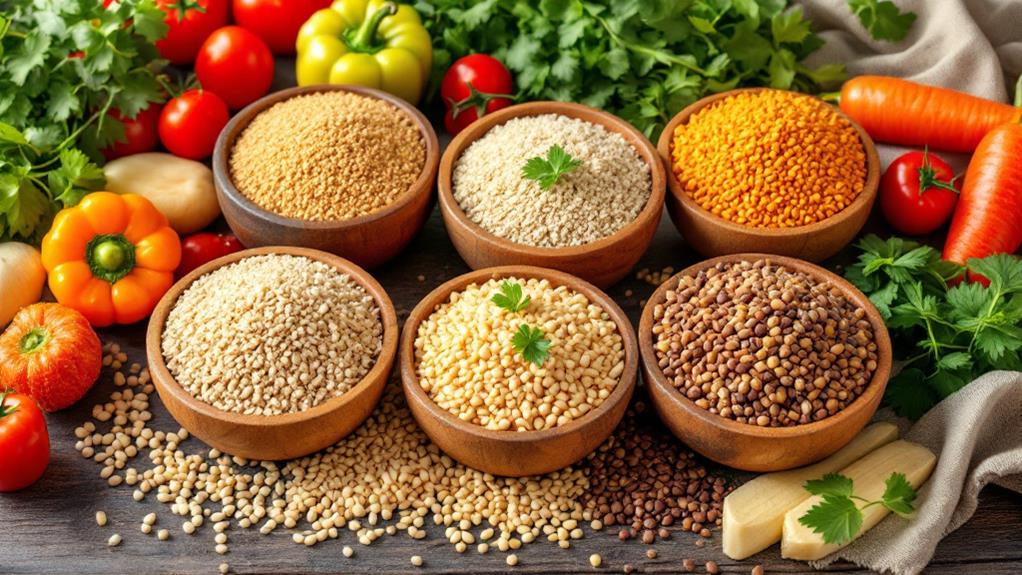
You're about to reveal a wealth of health benefits by embracing grains in your diet. Whole grains like oats and barley are packed with fiber, supporting heart health and digestion, while gluten-free options like quinoa offer complete proteins vital for vegans. Substituting white rice with nutrient-rich brown rice can elevate your intake of manganese and selenium. Grains help manage weight by promoting satiety and are linked to lower risks of chronic diseases. With diverse cooking techniques and global dishes, grains improve culinary versatility and nutritional intake. There's much more to grasp about grains' impressive health advantages.
Types of Common Grains
When considering the staples of global diets, common grains like wheat, rice, oats, corn, and barley immerse out for their distinct uses and nutritional benefits. As you investigate these grains, you'll see that each offers unique health advantages. Wheat is a versatile grain, primarily transformed into flour, but keep in mind it contains gluten. This makes it unsuitable for those with gluten intolerance. However, wheat's whole grain form provides significant fiber content, contributing to digestive health.
Rice, on the other hand, is a gluten-free powerhouse. It's one of the most consumed grains worldwide, available in different forms such as long, medium, and short grain. Its versatility and ease of digestion make it a staple in many diets. Oats are a standout for their high soluble fiber content, particularly beta-glucan, which supports heart health by helping to lower cholesterol levels.
Barley is another whole grain worth noting. It adds a nutty flavor to soups and stews and is a rich source of dietary fiber, vitamins, and minerals. The health benefits of incorporating these grains into your diet can be significant, enhancing overall nutritional intake and promoting well-being.
Nutritional Profile of Grains
Exploring the health benefits of common grains naturally leads us to their nutritional profiles, which reveal why they're so beneficial. Whole grains pack a punch with vital nutrients like fiber, B vitamins, and minerals such as iron, magnesium, and selenium. These components play critical roles in your overall well-being and metabolic functions. Fiber, abundant in whole grains, typically ranges from 2 to 8 grams per serving, aiding digestion, helping lower cholesterol levels, and promoting satiety.
Quinoa and amaranth stand out as whole grains that are complete proteins, containing all nine vital amino acids. This makes them especially valuable for vegetarian and vegan diets. Every grain has a unique nutritional profile. Brown rice is rich in manganese and selenium, vital for antioxidant protection and thyroid function. Oats boast high levels of soluble fiber, which is known for its ability to reduce cholesterol levels.
Incorporating whole grains into your diet is linked with a lower risk of chronic diseases, including heart disease and type 2 diabetes. This is due to their high nutrient density and positive effects on blood sugar regulation. By understanding these nutritional profiles, you can make informed choices for a healthier diet.
Health Advantages of Grains
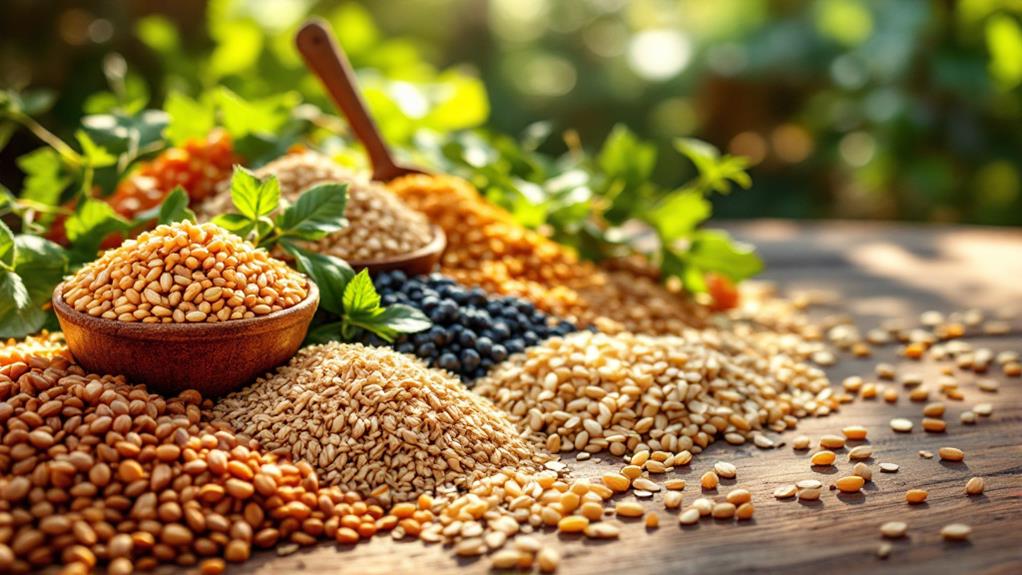
Whole grains offer a myriad of health advantages that can greatly improve your well-being. By incorporating these nutrient powerhouses into your diet, you reduce the risk of chronic diseases like heart disease, type 2 diabetes, and certain cancers. Thanks to their high fiber content, whole grains help lower cholesterol levels, regulate blood sugar, and promote healthy digestion. This fiber not only supports your gut health but also contributes to improved cardiovascular health. Studies show that higher consumption of whole grains leads to better cholesterol and inflammation markers, benefiting your heart.
Moreover, whole grains are packed with crucial vitamins and minerals, including B vitamins, iron, magnesium, and selenium, which play important roles in energy metabolism and immune function. These nutrients provide your body with the fuel it needs to perform at its best, enhancing your general health.
For those looking to manage their weight, whole grains are a smart choice. They promote satiety, helping you feel fuller for longer, which can reduce hunger levels and prevent overeating. This can lead to effective weight management and a lower risk of obesity. Incorporate whole grains in your diet to harness these impressive health benefits.
Incorporating Grains Daily
To effortlessly improve your nutrient intake and general health, make it a habit to incorporate whole grains into your daily meals. Aim for at least half of your grain consumption to be whole grains, which are packed with fiber and essential nutrients. Simple swaps make this easy—replace white rice with cooked brown rice or choose whole grain bread over white. These changes increase your nutrient consumption without sacrificing taste or texture, supporting a healthy diet.
Incorporating whole grains is straightforward:
- Add cooked quinoa or farro to salads and soups for extra fiber and nutrients.
- investigate different whole grains like amaranth or bulgur to diversify meals and enjoy assorted health benefits.
- Track your intake by aiming for three out of six daily servings to be whole grains, with one serving as half a cup of cooked grain.
These strategies guarantee you meet dietary guidelines effortlessly. By integrating whole grain foods into your meals, you'll not only improve nutrient intake but also enjoy delicious and varied dishes. Start making these simple swaps today to build a healthier diet and experience the benefits of whole grains directly.
Cooking Techniques for Grains
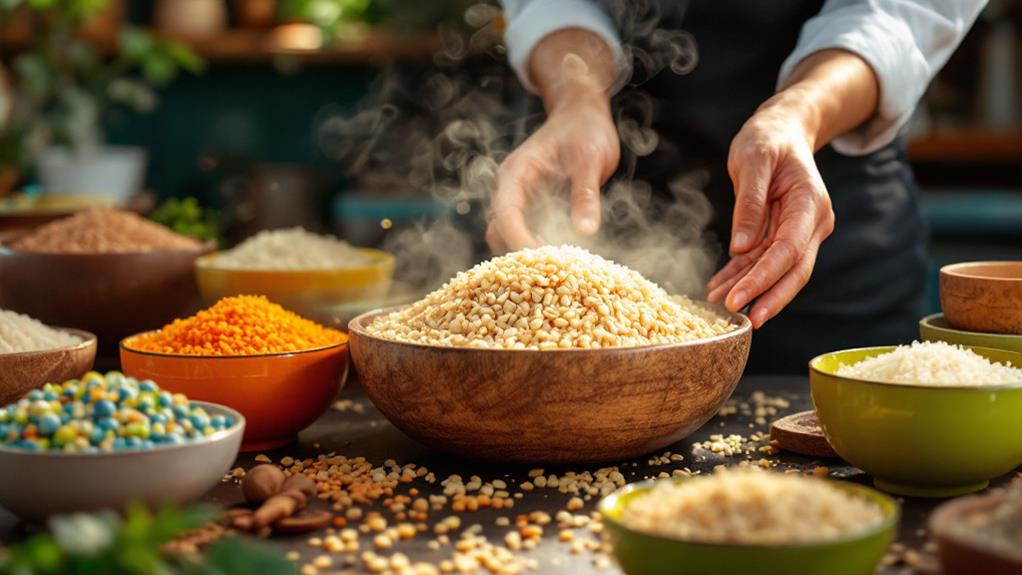
When cooking grains, understanding their unique requirements is vital for achieving the best results. Different grains call for specific water-to-grain ratios and cooking times. For instance, brown rice typically uses a 1:2 ratio and takes about 40-45 minutes to cook, while quinoa requires a 1:1.25 ratio, ready in just 15 minutes. Rinsing grains like quinoa before cooking is important to remove debris and bitter saponins, enhancing flavor.
Pre-soaking grains can greatly cut down cooking times, making it a valuable step in your preparation. Soaking barley for a few hours can halve its cooking time. Using a rice cooker or pressure cooker simplifies cooking whole grains, ensuring consistent results with minimal effort. These appliances are particularly useful for busy schedules, turning meal prep into a seamless task.
Once cooked, you can store cooked grains in the fridge for 3-5 days or freeze them for up to 3 months. This makes grains a convenient option for quick meal assembly. Regardless of whether you're preparing brown rice or quinoa, these techniques help you make the most of your grains, saving time while maximizing flavor and nutrition.
Gluten-Free Grain Options
For those seeking gluten-free grain options, there's no shortage of nutritious choices to investigate. Gluten-free grains like quinoa, millet, and amaranth offer excellent alternatives for anyone with gluten sensitivity or celiac disease. Quinoa stands out as a complete protein source since it contains all nine crucial amino acids. It's also a source of fiber and healthy fats, making it a versatile and fulfilling option. When cooking quinoa, use a water-to-grain ratio of 1 1/4 cups quinoa to 2 cups liquid.
Millet has a slightly sweet flavor, making it adaptable for numerous dishes. With a grain-to-water ratio of 1:2, millet is simple to prepare while remaining gluten-free. Its versatility allows you to incorporate it into many recipes, providing a nutritious alternative to traditional grains.
Amaranth is another gluten-free choice known for its high protein content and fiber. Before cooking, rinse amaranth and use a cooking ratio of 1 cup amaranth to 2.5 cups water.
- Always check labels for gluten-free certification.
- Cross-contamination can occur during processing.
- These grains are ideal for a gluten-free lifestyle.
These grains provide delicious and nutritious alternatives for those avoiding gluten.
Global Grain Dishes
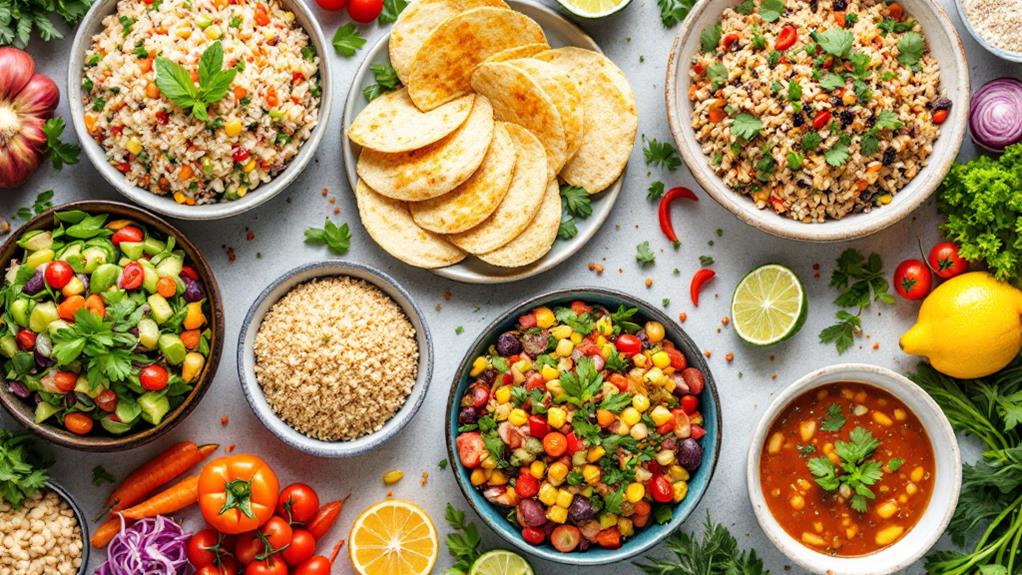
Exploring the world's grain dishes opens a gateway to varied culinary traditions and flavors. Whole grains like barley, teff, buckwheat, bulgur, and amaranth play starring roles in traditional cuisines across the globe, each offering unique health benefits and cultural significance.
Start with barley, often used in Scottish broth. This hearty soup combines barley with vegetables and meat, showcasing its high fiber content and comforting qualities in traditional cuisine. Then there's teff, the tiny Ethiopian grain crucial for making injera. This sourdough flatbread not only functions as a plate and utensil but also packs a nutritional punch with its rich nutrient density.
In the Middle Eastern tradition, bulgur shines in tabbouleh, a revitalizing salad with parsley, tomatoes, olive oil, and lemon juice. It's a versatile and healthy dish that highlights bulgur's role in wholesome Middle Eastern grain dishes. Meanwhile, buckwheat takes center stage in Japanese soba noodles, offering a gluten-free, protein-rich option perfect for varied preparations.
Lastly, amaranth finds its place in Mexican alegrías, a candy blending popped amaranth seeds with honey or sugar. This sweet treat underscores amaranth's cultural and nutritional allure, rounding out your global grain exploration.



